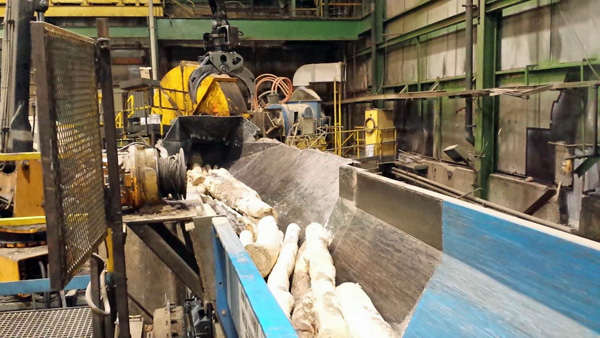Learn about the Wood Chippers Used in Paper Pulping
![]() Print this Article | Send to Colleague
Print this Article | Send to Colleague
The online blog Pulp Paper Mill (Dhaka, Bangladesh) this month (Aug. 2018) detailed how today's wood chippers work as part of the pulp and paper manufacturing process. The author explained that the wood chipper is used in pulp & paper mills to produce chips from pulpwood so that cooking chemicals penetrate the wood quickly, completely, and uniformly during manufacturing of either chemical pulp or mechanical pulp.
The process from pulpwood to chips is known as the chipping process. The sizes of the good quality chips can be 5/8 to 5/4 in. long and 3-6 mm thickness. Oversize chips can create cooking problems which increases screen rejection. On the other hand, fine chips and rotten chips can cause lower yield and strength problems. The available chippers are many sizes and styles. They are portable or stationary. Both the portable and stationary chippers in modern times have almost the same functions. Often, a truck or van is attached behind a portable wood chipper.

The pulpwood enters into the chute of the chipper and then once inside the blades cut the woodpulp into chips. The pulpwood is fed into the chipper as logs or as whole trees. Before entering the chipper, this feedstock should be free of bark. A debarker may be used before the chipper. Some chipper assemblies include both the debarking and chipping system. The efficiency of the chipper depends on productivity, power demand, fuel consumption, and product quality.
Types of wood chipper
The wood chipper or tree chipper can be different types depending on the model. Common model designs are currently the disc type, drum type, high torque roller, and screw type. Among these, the disc chipper and drum chipper are still the most common chippers in the pulp and paper industry and will be covered here in more detail. Both types have their own advantages and disadvantages. Mill management must choose which is right for their operation when a new mill is being built for the first time or when undergoing a refit / modernization of machinery.
Disc chipper
The disc chipper consists of a steel disc, spout, and chopping blades or knives. The knives are mounted on the disc. The number of knives may be 4, 8, or 12. The older chippers had 4-knifes which was lower capacity and produced more waste. Therefore, newer models come in multi-knives chipper containing 8, 10 and 12 knives which are higher capacity and produce less waste and better quality chips. All of them serve essentially the same purpose. The spout of the chipper may be rectangular or oval shaped. The rectangular shaped spout produces more uniform chips. Usually, the logs are fed to the disc by a sloping spout so that they remain at an angle. After a few hours of continuous operation it is standard procedure that the knives may be changed for sharpening. This process consumes worker time and creates additional downtime, but it assures the production of the most uniform wood chips possible at the mill. When the disc spins, blades then cut the pulpwood into chips. Exact sizes of the chipper depend on disc diameter, number of knives, spout etc.
Drum chipper
The drum chipper consists of large steel drum and blades or knives. The drum is parallel to the hopper. It has some drawback. For example, it creates large uneven chips and has safety issue. But it is more energy efficient compared to the disc type chipper. It produces more productive chips.
After the wood chipper, the chips are passed through screens for separate acceptable sizes chips from fine and oversized chips.The chips should be free of dirts, sand, mud, stone and other foreign materials. To assure this the chips are washed after passing the screen section. They are then sent to either a storage tank with conveyor belts or a pipe line for storage in silos. Outside storage of wood chips have some disadvantages. Surfaces chips can be easily contaminated with air borne pollutants.
More information is available by viewing this video about a Eucalyptus chipper online.


